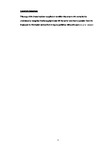The Effect of Rein Type and Bit Type on Rein Tension in the Ridden Horse
| dc.contributor.supervisor | McGregor, Dr Peter | |
| dc.contributor.author | O'Neill, Megan | |
| dc.contributor.other | School of Biological and Marine Sciences | en_US |
| dc.date.accessioned | 2018-11-19T17:13:07Z | |
| dc.date.issued | 2018 | |
| dc.date.issued | 2018 | |
| dc.identifier | 10432583 | en_US |
| dc.identifier.uri | http://hdl.handle.net/10026.1/12819 | |
| dc.description.abstract |
An important area of Equitation Science is rein tension; which is used to control ridden and unridden horses primarily using the application of negative reinforcement. Rein tension is affected by several variables including the rider, horse and equipment, although not all aspects of these variables have been studied. The work undertaken for this thesis comprised of three separate yet interlinked sections. The first identified (by qualitative questionnaire) the most commonly used bridle, reins and bit types and why the equestrian population use them. The results produced determined which rein and bit types would be trialled in the second and third sections. Rubber reins were the most commonly used (49.45%); while the snaffle family were highlighted to be the most popular bit type (84.71%). Section two evaluated the rein tension applied by 5 rein types (rubber, continental, laced leather, thick leather and thin leather). Rein type significantly affected rein tension (One-way Analysis of Variance; F4,1060=20.13; P<0.001); was highest for rubber (12.928±0.377N) and continental reins (12.399±0.54N) and lowest for laced (9.730±0.377N), thick (9.618±0.368N) and thin reins (9.157±0.352N). The third section aimed to produce baseline data for the snaffle family of bits. 14 bit types were trialled across 29 horse and rider dyads. Bit type had a significant effect on rein tension (One–way Analysis of Variance; F13,506=18.35; P<0.001). Overall, the results show rein tension varies significantly with rein and bit type. Given the impact of rein tension on the horse’s welfare understanding these variables is essential for ethical and sustainable equitation. | en_US |
| dc.language.iso | en | |
| dc.publisher | University of Plymouth | |
| dc.subject | Equitation | |
| dc.subject | Rein tension | |
| dc.subject | Rein | |
| dc.subject | Bit | |
| dc.subject | Negative reinforcement | |
| dc.subject | Welfare | |
| dc.subject | Horse | |
| dc.subject | Equitation Science | en_US |
| dc.subject.classification | ResM | en_US |
| dc.title | The Effect of Rein Type and Bit Type on Rein Tension in the Ridden Horse | en_US |
| dc.type | Thesis | |
| plymouth.version | publishable | en_US |
| dc.identifier.doi | http://dx.doi.org/10.24382/1130 | |
| dc.rights.embargodate | 2019-11-19T17:13:07Z | |
| dc.rights.embargoperiod | 12 months | en_US |
| dc.type.qualification | Masters | en_US |
| rioxxterms.version | NA |
Files in this item
This item appears in the following Collection(s)
-
01 Research Theses Main Collection
Research Theses Main


